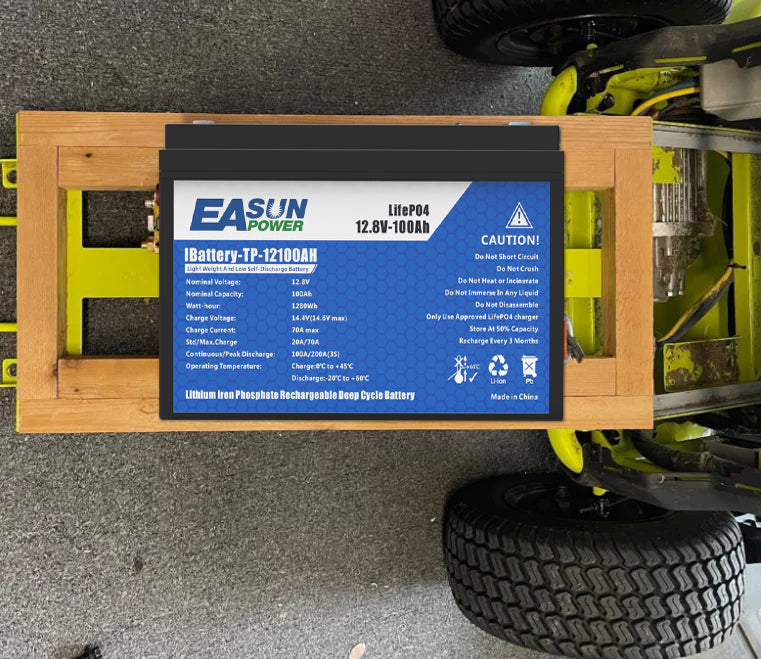
How do I safely charge my Lifepo4 battery?
Lithium iron phosphate (LiFePO4) batteries are popular for their high energy density and long cycle life. To ensure the safety and optimal performance of LiFePO4 batteries, it is critical to follow proper charging methods and guidelines.
This paper discusses charging methods, and safety tips for charging LiFePO4 batteries.
LiFePO4 Battery charging methods
In this section, we'll take an in-depth look at the best method of charging LiFePO4 batteries. Whichever charging method you choose, it is critical to confirm compatibility between your chosen charger and your LiFePO4 battery. This will ensure optimal performance, longevity and safety during charging.
Charge with solar energy
Charging LiFePO4 batteries with solar energy is a sustainable and environmentally friendly method. This method utilises a solar charge controller that efficiently manages the energy generated by the solar panels and regulates the charging process to ensure optimal power delivery to the LiFePO4 battery. This application is ideal for off-grid setups, remote locations and environmentally conscious energy solutions.
Charge with AC power source
Charging LiFePO4 batteries with AC power is versatile and reliable. In order to optimise the use of AC power for charging LiFePO4 batteries, a hybrid inverter is recommended. This type of inverter includes, in addition to the integrated solar charge controller, an AC charger that can charge the battery from both the generator and the grid. This approach is suitable for both grid-connected and standby power systems, providing flexible charging options.
Tips for charging LiFePO4 safely
Tips for charging lifepo4 in parallel
- Make sure the batteries are of the same brand, type and size.
- When connecting LiFePO4 batteries in parallel, please make sure that the voltage of each battery is within 0.1V before connecting them in parallel.
- The difference in internal resistance between any two batteries is less than 0.05 Ω. Make sure that all cables and connectors are of the same length and size to ensure that the internal connections have the same resistance.
- When charging batteries in parallel, the solar charging current is halved and the maximum charging capacity is doubled. For example, if two 48V 100Ah batteries are connected in parallel, the maximum charging current of each battery is 50 A. In this configuration, the total charging current of the combined battery pack can be up to 100 A. Assuming that the State of Charge (SOC) of the two batteries is the same, the effective charging current of each battery pack will be 50A.
Tips for charging lifepo4 in serie
- Before charging in series, please make sure that each battery is of the same type, brand and capacity, otherwise it will lead to an imbalance in voltage between the batteries, resulting in over- or under-charging and affecting the performance and life of the batteries.
- When connecting batteries in series, please ensure that the voltage between each battery is within 50mV (0.05V) before connecting them in parallel. This will limit the chances of an imbalance between the cells. If your cells become unbalanced and the voltage of any cell differs by more than 50mV (0.05V) from the voltage of another cell in the group, recharge each cell separately to rebalance.
Whether You Can Charge the Battery Directly with a Solar Panel
It is not desirable to use solar panel to charge the battery, because the output voltage and current of the solar panel will change with the intensity and angle of the sunlight, which may exceed the charging range of the lithium iron phosphate battery, resulting in over-charging or under-charging, which will affect the performance and life of the battery.
Therefore, to safely use solar panels to charge lithium iron phosphate batteries, you need to add a charge controller between the solar panel and the battery.
LiFePO4 Temperature Compensation
Lithium Iron Phosphate batteries do not require temperature compensation for voltage when charging at high or low temperatures. All LiFePO4 batteries are equipped with an internal BMS that protects the battery from both low and high temperatures. If the BMS is disconnected due to low temperature, the battery must be warmed up before the BMS can reconnect and receive charging current. If the BMS is disconnected due to high temperatures, the battery will need to cool down before the BMS can accept charge current. Refer to the data sheet for the specific battery for BMS low and high temperature cutoffs and reconnect values.
